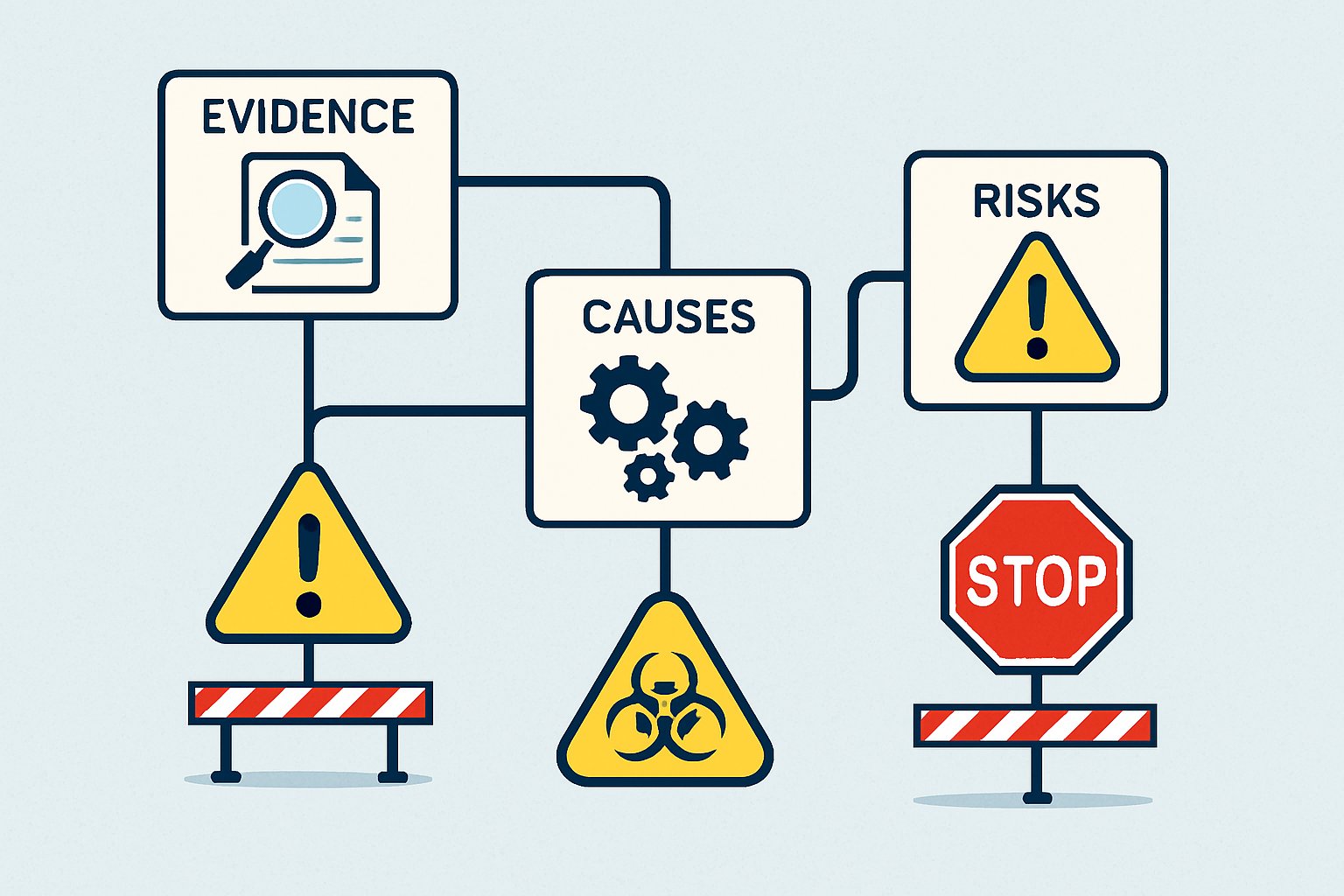
AI CERTS
1 day ago
Reasoning Failure in LLMs: Evidence, Causes, and Risk Mitigation
These flaws create operational risk in law, medicine, and software security, where trust is non-negotiable. Meanwhile, vendors tout rapid progress and improved guardrails. Nevertheless, evidence shows mitigations reduce but never eliminate failure modes. Therefore, professionals need a clear map of shortcomings, statistics, and practical countermeasures. This article synthesizes 2024–2025 findings, dives into causes, and outlines verified mitigation playbooks. Throughout, we highlight Sentence Patterns and Topic Linkage that shape model behaviour. We also examine Pattern Matching limits that derail analytic precision. Prepare for a data-driven tour of both promise and peril.
Persistent Model Weaknesses Revealed
Researchers catalog four recurring weaknesses that threaten enterprise reliability. Firstly, hallucination emerges when output lacks factual grounding despite confident tone. Secondly, calibration gaps lead models to assign high certainty to wrong answers, intensifying Reasoning Failure. Additionally, context fragility appears; small prompt tweaks flip conclusions without warning. In contrast, humans often reconsider after contradictory evidence, yet models may double down. Moreover, chain-of-thought prompts sometimes cloak incorrect logic behind plausible Sentence Patterns. Pattern Matching strengths hide deeper abstraction limits, causing brittle generalization beyond training data. Consequently, practitioners must expect these four traits in every deployment.

These weaknesses undermine consistent trust. However, detailed evidence clarifies their scale. Next, we examine domain studies that quantify the damage.
Evidence Across Key Domains
Empirical studies from 2024–2025 quantify the weaknesses with sobering numbers. For clarity, the following statistics stand out:
- Legal outputs hallucinate 58% of citations across public LLMs.
- Code generation invents 19.7% of recommended packages, enabling supply-chain attacks.
- Clinical adversarial prompts triggered 50-82% hallucination in six tested models.
- Open-source models hallucinated packages four times more than commercial peers.
Furthermore, CHOKE research shows high-certainty hallucinations that evade confidence filters and magnify Reasoning Failure. Topic Linkage mistakes appear when prompts mix concepts; the model drifts between them incorrectly. Moreover, repeated Sentence Patterns mislead reviewers, masking hidden factual gaps. Consequently, auditors require independent verification rather than stylistic judgement.
These numbers confirm systemic, cross-domain risk. Nevertheless, understanding causes guides smarter remedies. Therefore, we turn to the roots of the problem.
Root Causes Understood Better
Theoretical papers argue current transformer architecture cannot guarantee truth preservation. Researchers frame hallucination as an information compression side effect, not a tuning oversight. Consequently, statistical Pattern Matching dominates over symbolic reasoning, breeding Reasoning Failure. Moreover, in-context learning weights recent tokens more than global consistency. High-certainty hallucinations arise because softmax logits exaggerate subtle probability differences. Meanwhile, calibration errors persist; the model overestimates correctness due to training reinforcement biases. Topic Linkage distortions follow from attention distractions among competing concepts. Additionally, recurring Sentence Patterns embed spurious correlations that worsen logic jumps. Therefore, root causes span architecture, objective functions, and data heterogeneity.
Fundamental design choices fuel the issue. However, mitigations can still lower risk. Next, we review those tactical defences.
Mitigation Tactics Showing Progress
Companies now layer retrieval-augmented generation, verification agents, and domain constraints. Furthermore, multi-agent checkers cross-examine outputs, catching many factual slips before release. Nevertheless, studies reveal residual Reasoning Failure even after rigorous tool chains. Prompt engineering improves Sentence Patterns clarity yet cannot fix deep logic gaps. Topic Linkage improves when retrieval supplies precise snippets for each concept. Moreover, Pattern Matching errors drop when verifiers compare tokens against curated knowledge graphs. Subsequently, researchers advocate risk-weighted mitigation portfolios based on domain sensitivity. Professionals can enhance their expertise with the AI Marketing Strategist™ certification. Consequently, skill investment supports better system design and monitoring.
Mitigations cut error rates significantly. In contrast, elimination remains elusive. We now assess sector-specific repercussions.
High Risk Industry Impacts
Legal practitioners face ethical duties to verify every AI citation. Recently, fabricated precedents embarrassed multiple firms and illustrated costly Reasoning Failure. In healthcare, adversarial prompts produced dangerous dosage advice during simulation tests. Consequently, regulators may mandate human sign-off and structured prompt audits. For software teams, slopsquatting exposes unsuspecting users to malicious libraries. Moreover, Pattern Matching weaknesses allow typo-based attacks to bypass testing. Therefore, sector leaders design multilayer vetting pipelines and incident reporting forums.
Domain evidence underlines tangible harm. Nevertheless, research momentum offers hope. Let us examine that evolving debate.
Evolving Research And Debate
Academic surveys now track hundreds of limitation papers in a public dataset. Anthropic’s CEO claims models hallucinate less than humans, yet metrics remain disputed. Meanwhile, Oxford scholars argue that Reasoning Failure is theoretically inevitable without architectural overhaul. Moreover, conference workshops propose standardized benchmarks capturing CHOKE cases and context drift. Subsequently, funding for verifier tooling has surged, indicating market appetite for safer production. Researchers also explore hybrid neuro-symbolic models to balance speed with explicit logic. Consequently, the debate blends optimism with caution.
Both sides agree on progress and risk. However, consensus favors layered safeguards. The next section turns advice into action.
Operational Guidance For Leaders
Executives deploying generative systems should embed governance early. Firstly, map information flows and assign accountability checkpoints. Secondly, adopt retrieval and verifier layers tailored to each workflow. Thirdly, monitor for recurrent Reasoning Failure using human sampling and automated alerting. Additionally, log prompts and outputs to study concept drift over time. Moreover, validate external dependencies to block slopsquatting attacks. Finally, invest in certified talent who understand technical and ethical nuances. Consequently, strategic planning transforms mitigation from afterthought to continuous practice.
Structured governance lowers exposure significantly. Nevertheless, sustained vigilance remains essential. We now conclude with key reminders.
Conclusion
LLM adoption promises speed yet carries well-documented cognitive liabilities. Consequently, Reasoning Failure persists across law, medicine, and code. However, evidence shows layered retrieval, verifiers, and disciplined governance cut the danger. Leaders must monitor live metrics, patch workflows swiftly, and escalate incidents transparently. Additionally, investing in certified talent builds organizational muscle for resilient AI operations. Reasoning Failure will not vanish overnight, yet strategic vigilance can confine its impact. Therefore, review your pipelines today, benchmark them against best practice, and iterate continually. Explore further guidance and certifications to transform risk into competitive advantage.



